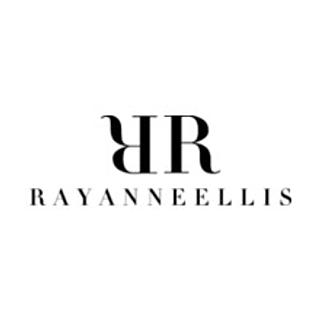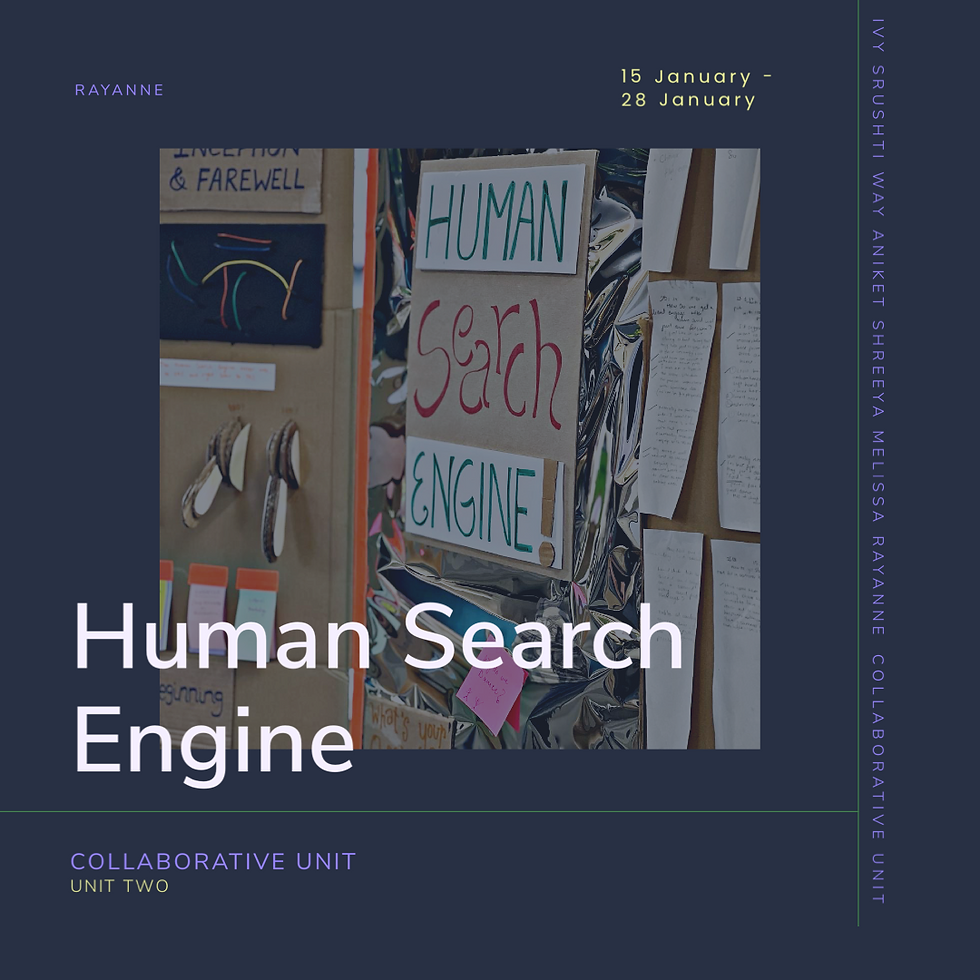UX of Co-Presence
- Rayanne Ellis
- Apr 11, 2024
- 12 min read
Unit: Macro
Team members: Binoy, Elena, Malayaka, Swaranjali and Rayanne
Brief: Design a way for feelings to spread between people for Performance Company BitterSuite
Company: BitterSuite
Contents
WEEK ONE: BRIEF FAMILIARISATION
Monday 5 February - Sunday 11 February
Performance Company BitterSuite
To help us understand the brief, BitterSuite demonstrated their sensory performance Bodies Titled (2023) which uses sound, movement, smell and taste to deepen people’s experience with music. I learnt they are seeking new ideas on how to increase the empathetic connection between their audience (those who watch their performance) and those who are active participants in their performance.
Ideation on Brief
Performances are known to transmit senses to an audience to create shared emotions (Banes and Lepecki, 2012). However, given BitterSuite were looking for new ideas I was interested in stepping away from performance and exploring how other environments influence our emotions and triggers emotional contagion. Emotional contagion is being exposed to a person's expression of emotions that results in your own emotions becoming similar to that person's. (Hatfield et al, 1994 and Goldenberg and Gross, 2020). I collated my thoughts on our groups collaborative board for discussion.
Fig. 1 My analysis of the brief and our research questions created by Binoy. Fig. 2 My initial ideas on the brief.
Creating two groups
As a group of 10 we hoped to split strategically based of our areas of interest. However, after length back and forth discussions we decided to divide into two groups using a random generator for efficiency. During Thursdays presentation I was inspired by how the Pembroke House Group were collaborating together and splitting up strategically to conducted research. I would like to explore how to continue working with the other BitterSuite group to support each other's project development.
Planning our project
We got together to plan out the next three weeks and went over our research questions. From this we decided to focus on where the phenomena of emotional contagion exists outside of a performance

Fig. 3 Our project roadmap following our planning session.
Turn it Up Exhibition & AEIOU
We brainstormed the environments and events where emotional contagion could exist and reframed our research question, we decided to use the AEIOU method, an organisational framework for documenting and coding information observed under Activities, Environments, Interactions, Objects and Users (Martin and Hanington, 2019), to gain insights into how emotional contagion happens and why.

Fig. 4 Our thoughts on places to explore emotional contagion.

Fig. 5 A list of places we could go in London based of fig. 4.
We went to the Turn it Up Exhibition (2024) which Binoy suggested to observe how people behave in museums but also the connection between music and emotions something key to BitterSuite’s Bodies Tilted performance. Following the experience we reviewed our findings and grouped them into key themes.
Fig. 6 Our findings from the Turn it Up Exhibition (2024). Fig. 7 AEIOU written documentation. Fig. 8 Organisation of AEIOU data. Fig. 9 Visualisation of emotions listening to Royal Philharmonic Orchestra during the exhibition.
Fig. 10 Video of the exhibition
Reflections on our research
At the exhibition we did not interview other attendees this was a missed opportunity to get wider insights. Also, the experience was insightful on music’s influence on emotions, however, we need to do further research to expand our knowledge on emotional contagion.
We agreed next steps then presented our research to the group on Thursday

Fig. 11 Next steps following week one.
Presentation feedback
Going to the Turn it Up Exhibition was a good starting point however, we should consider how to link practice to theory.
Our categories of places to explore were subjective e.g. good experiences can be bad for others, we should consider this when conducting research.
Empathy may distract us from emotional contagion and difficult to really measure.
When ideating consider how to take someone on a journey of feelings through an experience.
WEEK TWO: EXPLORING RESEARCH QUESTIONS
Monday 12 February - Sunday 18 February
Environments & emotional contagion
Following the presentation feedback to link theory to practice we decided to review our research questions (see fig. 1) further in secondary research. I continued to look into environments where we experienced shared emotions. Inspired by pictures of the Yorkshire Dales I began to explore nature as an environment, its impact on emotions and emotional contagion. Binoy explored cross-modality
Fig 12 Secondary research I conducted on nature as an environment for emotional contagion. Fig. 13 Secondary research Binoy conducted on Crossmodality.
Observations & interviews at the Barbican Centre
Tuesday we went to the Barbican Centre, we conducted AEIOU and interviews to explore how emotions change across different environments within the Centre (gallery, library, public space, theatre etc).

Fig. 14 Findings from Barbican Centre
To analyse our primary research we created a collage of our key outputs. This collage helped visualise our findings however, we could have gone further and used it to cross analyse our findings and link our theory to practice.

Fig. 15 Findings visual from the places we visited.

Fig. 16 Headline findings from each place observed
Human interaction experimentation
Most of our research had been done on a large scale, Swaranjali, Malaysia and Elena highlighted it would be interesting to observe emotional contagion on a micro level. Drawing inspiration from Marina Abramovic performance during her Artist is Present (2010) Exhibition at the MoMA, we created a gaze experience to understand if people simply looking at each other could evoke a feeling of connection and lead to emotional contagion.
Fig. 17 Images of the gaze experiment. Fig. 18 Findings from the gaze experiment.
Reflecting on research and reanalysing using the Matrix Model
Between crossmodality, empathy, human interaction, nature, and music we had to many avenues of thought preventing us developing a clear narrative. Alaistair suggested we use the Matrix Model to reanalysed our findings. Tetris (2022) suggests the matrix model can help to look across themes and create a visual representation of data to draw findings from.
I adapted the Matrix Model into a grid format, with the Y-axis categorising our research on a spectrum of emotions from negative to positive, aligning with Fischer's (1990, quoted in Hatfield et al, 1994, p. 3) suggestion that emotions can be separated into these categories. This enabled us to explore the emotional responses we wanted for our experience. The X-axis categorised our research based on scale, from macro (large-scale) to micro (small-scale), determining the desired scope of our experience.
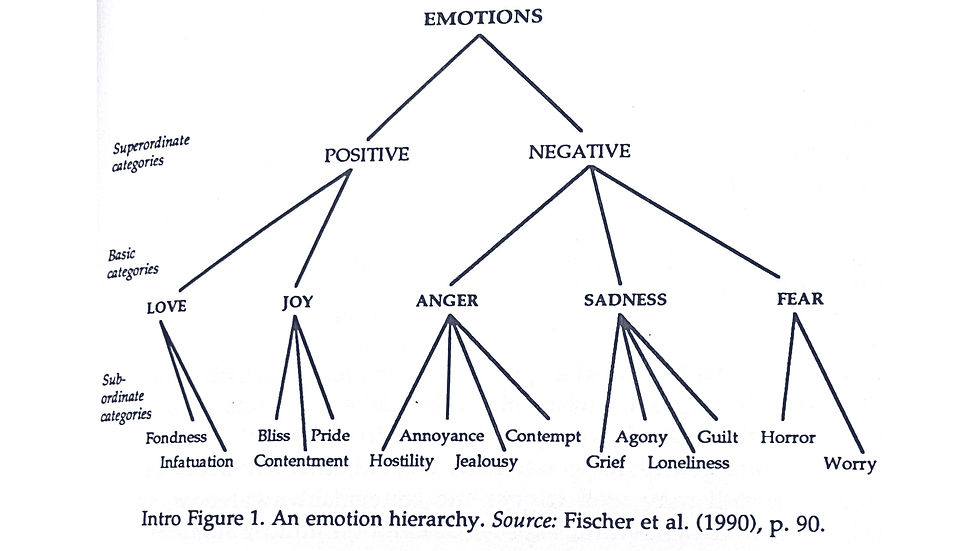
Fig. 19 Fischer (1990) diagram of emotions cited in Hatfield et al (1994).

Fig. 20 our matrix model outcomes, the black circles outline our analysis of each group identified.
Reanalysing our research using the matrix model provided a structured way to cross examine our findings, draw out key themes and decide what we’d like to focus on going forward.

Fig. 21 chosen theme (Nature) from our analysis of the Matrix Model.
Presentation feedback
The objective of the gaze experience was not clear, nor was it’s relation to our secondary research. The experience also lacked guidance resulting in participants being unclear on how to respond i.e. people seeing it as a staring competition rather than about emotional contagion.
The aspects of nature were missing in our primary research. How could we bring the richness of the natural world into our experience and future research?
WEEK THREE: EXPLORING NATURE AS A CONCEPT
Monday 19 February - Sunday 25 February
Share your plant stories
We each shared ideas and concepts on how we could use nature to evoke and spread emotions, from this I sketched out a concept utilising everyone ideas. Given we wanted to involve plants in our concept we decided to conduct a directed storytelling session focused on peoples interaction with plants. We aimed to trigger participants' memories of their own plants, encourage them to share stories and explore emotional contagion.

Fig. 22 an initial concept I sketched out following a group brainstorm.

Fig. 23 depicts our directed storytelling setup, chosen over interviews to create a visually engaging environment with plants and personal stories.
Fig. 24 Participants engaging in the directed storytelling session.
We analysed the stories shared through affinity diagramming, we grouping the stories based on similarities, gave them headings and discussed what they meant to us and our concepts (Martin and Hanington 2019) .

Fig. 25 the stories people shared and our analysis of these stories
Emotional journey mapping
We attempted to employ emotional journey mapping, a method to reflect on the emotional status of participants during each stage of our experience (Følstad and Kvale, 2018), to plan our concept. However, we found our concept was too underdeveloped to complete this journey.
Nevertheless, the process did help us realise that we wanted people to interact with each other as part of our experience. Consequently, we decided to transform our plant-directed storytelling research into an interactive workshop.
During our presentation, Stephanie Singer, Founder of BitterSuite, advised us to anticipate the audience's emotional journey in our experience. I believe emotional journey mapping could serve as the foundation for staying ahead if implemented once we have an agreed concept.
Plant-potting workshop
The workshop aimed to explore how people interact with each other through nature as a medium and to evoke a shared feeling of care and calmness. Initially planned as a pop-up in a park, the weather forced us indoors. To compensate, we incorporated nature-inspired music and warm lighting to enhance the calming atmosphere. Additionally, I conducted feedback sessions with each participant to understand their experience. To analyse our findings, we reviewed user quotes and observations to identify key themes.
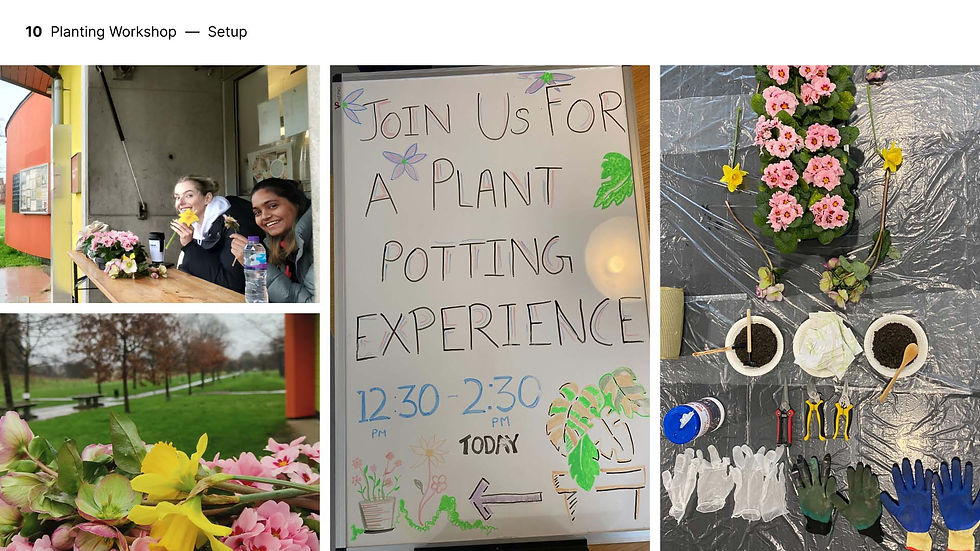
Fig. 26 Our plant potting setup, transitioning from outdoors to indoors at Malayaka and Swaranjali's Student Accommodation.
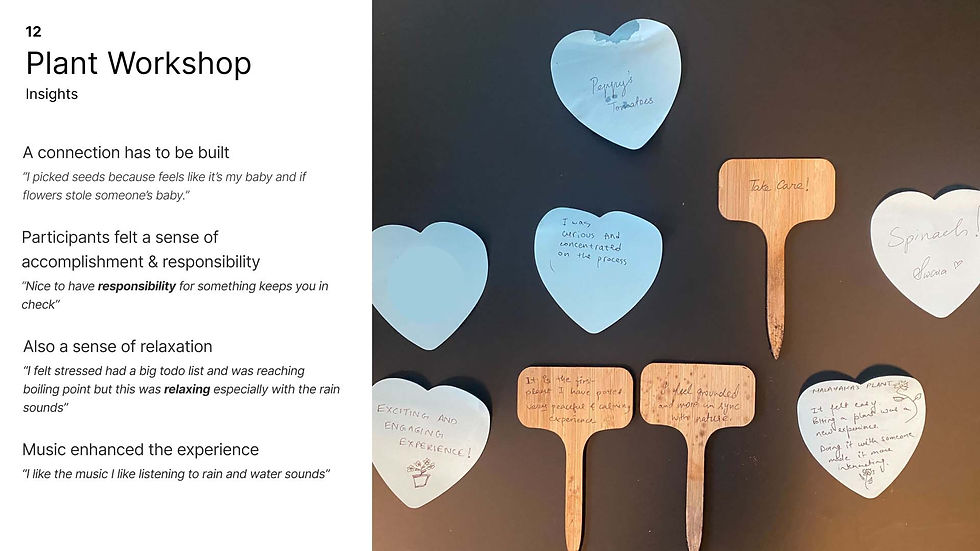
Fig. 27 key findings from the plant potting workshop
Fig. 28 Video of the plant potting workshop
Critical reflection on our nature concept
Throughout the week, we questioned the role of nature, these concerns also surfaced in our presentations and tutorials. Alastair pointed out that we seemed to have lost sight of the grandeur of nature, while Steph challenged us to consider why we were solely focusing on calmness when nature can also evoke fear. Additionally, Donna Harroway (2016) highlights the juxtaposition between humans benefiting from nature for capitalist gain or emotional solace, while simultaneously disconnecting from nature and causing it harm. This was emphasised when a participant in the plant-potting workshop expressed, "Touching the soil highlighted how disconnected I feel from nature," something we had overlooked in our analysis and concept generation.
Following presentations we felt stuck unsure if to continue down the nature path or to move onto something else. We discussed with Steph how we got here and our starting point of exploring different environments and how they trigger emotional contagion. Stephanie Singer suggested we go back to this moment and see where it takes us.
WEEK FOUR: PIVOTING ON OUR CONCEPT AND EXHIBITING OUR WORK
Monday 26 February - Sunday 3 March
Coming back to environments & exploring imagination
Following Stephanie's advice, I shifted my focus from nature back to environments and their impact on shared human emotions. I read Augusto Boal's “Games for Actors and Non-Actors” (2002). Which demonstrates how role-play, environments and voluntary participation can highlight the real issues faced by marginalised people. Reading his tool "Imaginary Journeys" prompted me to consider how imagination could facilitate exploration of environments and emotional contagion. It also brought to mind an image shared by Elena, illustrating people using blank spaces to craft their own environments.

Fig. 29 explanation of the Imaginary Journey tool by Augusto Boal (2002, pp. 117)
As a group we shared our concepts and agreed to use imagination, cues, performance, objects and spaces to spread feelings amongst people.

Fig. 30 tools we'd like to use in our concept

Fig. 31 an initial concept I drafted from the tools we'd identified.
Exploring imagination & environments at the Work in Progress Exhibition
We decided to incorporate testing key tools at the Work in Progress Exhibition. From Elena's suggestions we opted to test simply taping out spaces on the floor and asking people to imagine a place they did or didn’t want to be, then physically draw it. This was to assess if people could use their imagination to create different environments.
Fig. 32 our exhibition space and activity sheet, Fig. 33 Close up of activity sheet and prompt. Fig 34 Elena's mockup of the activity, Fig. 35 Close up of exhibition posters created by Binoy & Elena
Exploring collective imagination & emotional contagion
While our exhibition activity demonstrated that people can imagine different environments, we needed to explore whether the collective imagination of various environments could trigger emotional contagion. To do this, Rania, Ivy, and Min offered to participate in a session where we created two geometrical and one abstract shape on the floor, and asked them a series of prompts.
Fig. 36 & 37 testing our experience with Rania, Min and Ivy.
Reflectioning on our concept
This session with Rania, Ivy and Min showed there was something in our concept, it demonstrated imagination can be contagious and can evoke shared feelings among participants. The tape on the floor create boundaries, separating participants spaces. As participants removed the tape, the boundaries disappeared, leading to shared spaces where individuals integrated into each other's environments or crafted new ones altogether, sparking emotional contagion.
However, we also realised the importance of clarity in our prompts and guiding the participants throughout the experience, emphasising the beginning and end of each experience.
Subsequently, we presented our findings and outlined our next steps during the exhibition on Thursday.
Presentation feedback
During our presentation, we received praise for revisiting theory and demonstrating how it influenced our direction. However, Alaistair suggested that we could have expanded on our taped shapes at the exhibition by creating larger, more abstract shapes. Alaistair and Tonicha also recommended extending our testing beyond the university environment to public spaces, to observe how different settings influence the overall experience. Moore suggested watching "City Spaces, Human Places" by William Whyte (1981) to inspire ideas for public spaces to test within.

Fig. 38 next steps following week four
WEEK FIVE: REFIING CONCEPT & PRESENTING TO BITTERSUITE
Monday 4 March - Sunday 10 March
The ideal group size and effective prompts
We tested our experience with various group sizes and prompts, we realised that using creative, story-like prompts instead of plain directives helped immerse people in the experience and fostered imagination. Additionally, we found three people was the optimal number, as it encourages collaboration without overwhelming participants, allowing for better interactions.

Fig. 39 from left to right testing in a group of 3, a big group and then back to 3 participants.
Creating a story arch
We needed to revisit journey mapping to create effective prompts for our experience and to establish a clear narrative. Elena suggested incorporating a hero's journey into our experience, a narrative structure associated with Joseph Campbell (1973). We simplified Campbell's stages into three: the set-up, confrontation, and resolution, and created a narrative around these stages to test.
Fig. 40 final hero story and fig. 41 is the initial hero story
Exploring spaces for our experience
Based on Moore’s suggestion, I watched "City Spaces, Human Places" by Whyte (1981). I was inspired by the way people appropriated the spaces between office buildings, around fountains and plazas and transformed these spaces into their own environments. I was eager to explore and test our experiences in similar spaces.
Based on this inspiration, we decided to test our ideas in the park. However, we encountered challenges as our tape didn’t adhere to the ground, and our ribbons blew away in the wind. So we shifted our location indoors to a communal living room within a university hall.

Fig. 42 set up within the park and testing within the communal library
Reflections
Elena did an excellent job facilitating the session, highlighting the importance of the facilitators role, but also the need to systematise the facilitation so others could facilitate successfully. Furthermore, we realised our current approach lacked consideration for audience engagement and involvement. I also considered ways to express gratitude to participants, such as offering them a drawing of the space they helped create.
Instead of tape Binoy suggested creating a reusable solution using ribbons and Velcro. However, people seemed to prefer the simplicity and usability of the tape. In future iterations, I would like us to create a solution to combine the reusability of the ribbons with the functionality of tape.
Testing with an audience
For our final set-up I created a template to visualise the environments created. We then set up an experience with participants and audience members. We asked the audience members to watch the experience and document it use the template. We also tested prompting the audience to give suggestions to the participants. Audience involvement was a nice addition however, we needed improve the audience onboarding so the audience knew how and when to engage or just observe.

Fig. 43 template in use for the audience to visualise the environments participants were creating.
Fig. 44 final set up with ribbons instead of tape no audience
Fig. 45 Final set up with audience members and tape
Presentation feedback
BitterSuite praised our experience, they felt it was engaging to watch, the tape was genius as people knew it was something they could shift and Elena was a brilliant facilitator with a great script. BitterSuite, Tonicha and Alaistair also provided helpful suggestions for improvement by promoting us to explore:
how to involve the audience from the beginning
how to evolve our emotional arch through various emotional triggers
establishing onboarding and off boarding from the emersion and rules around the space
consider how to turn the experience into a design for someone to take forward
REFERENCES
Banes, S. and Lepecki, A. (2012) The Senses in Performance. New York: Routledge.
BitterSuite Presents Bodies Tilted (2023), Southbank Centre, London. 11 - 18 June 2023. Available at: https://www.southbankcentre.co.uk/whats-on/gigs/bittersuite-presents-bodies-tilted (Accessed: 11 April 2024)
Boal, A. (2002) Games for actors and non actors. 2nd edn. London: Routledge
Cambell, J. (1973) The hero with a thousand faces. 2nd edn. Princeton: Princeton University Press
Følstad, A. and Kvale, K (2018) ‘Customer journeys: a systematic literature review’, Journal
of Service Theory and Practice, 28(2), pp. 196 - 227. Available at: https://doi.org/10.1108/JSTP-11-2014-0261 (Accessed: 11 April 2024)
Goldenberg, A. and Gross, J.J., 2020. ‘Digital emotion contagion’. Trends in cognitive sciences, 24(4), pp.316-328. Available at: 10.1016/j.tics.2020.01.009
Martin, B. And Hanington, B. (2019) Universal Methods of Design. Beverly: Rockport Publishers.
Harroway, D. (2016) ‘Tentacular Thinking: Anthropocene, Capitalocene, Chthulucene’, e-flux Journal, 75. Available at: https://www.e-flux.com/journal/75/67125/tentacular-thinking-anthropocene-capitalocene-chthulucene/ (Accessed: 11 April 2024).
Hatfield, E., Cacioppo, J., Rapson, R. (1994) Emotional Contagion. Cambridge: Press Syndicate of the University of Cambridge.
Internet Archives (2019) City Spaces, Human Places by William Hollingsworth Whyte, WGBH (Television station : Boston, Mass.). 23 November. Available at: https://archive.org/details/CitySpacesHumanPlaces (Accessed: 11 April 2024).
Marina Abramović Artist is Present (2010) [Exhibition]. Museum of Modern Art, New York. March 14, 2010 - May 31, 2010. Available at: https://www.moma.org/calendar/exhibitions/964 (Accessed: 11 April 2024).
Terzis, L., Saltzman, L., Logan, D., Blakey, J. and Hansel, T. (2022) ‘Utilizing a Matrix Approach to Analyze Qualitative Longitudinal Research: A Case Example During the COVID-19 Pandemic’, International Journal of Qualitative Methods, 21, article number 16094069221123723. Available at: https://doi.org/10.1177/16094069221123723
Turn It Up: The Power of Music (2024) [Exhibition], Science Museum, London. February 3 2024 - May 6, 2024. Available at: https://www.sciencemuseum.org.uk/see-and-do/turn-it-up (Accessed: 11 April 2024)
